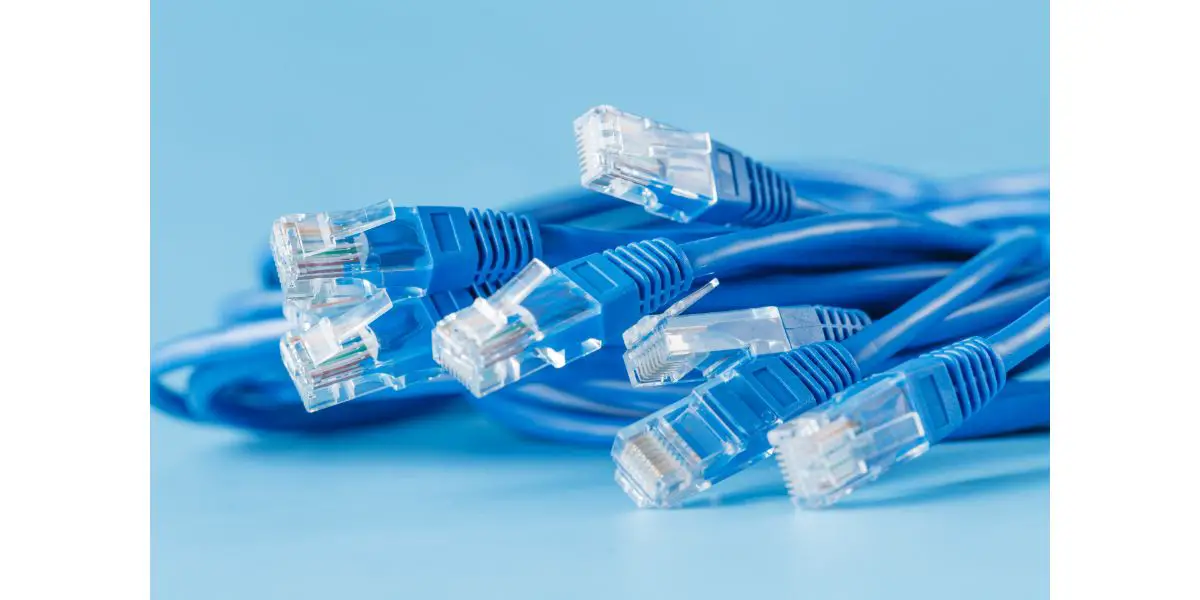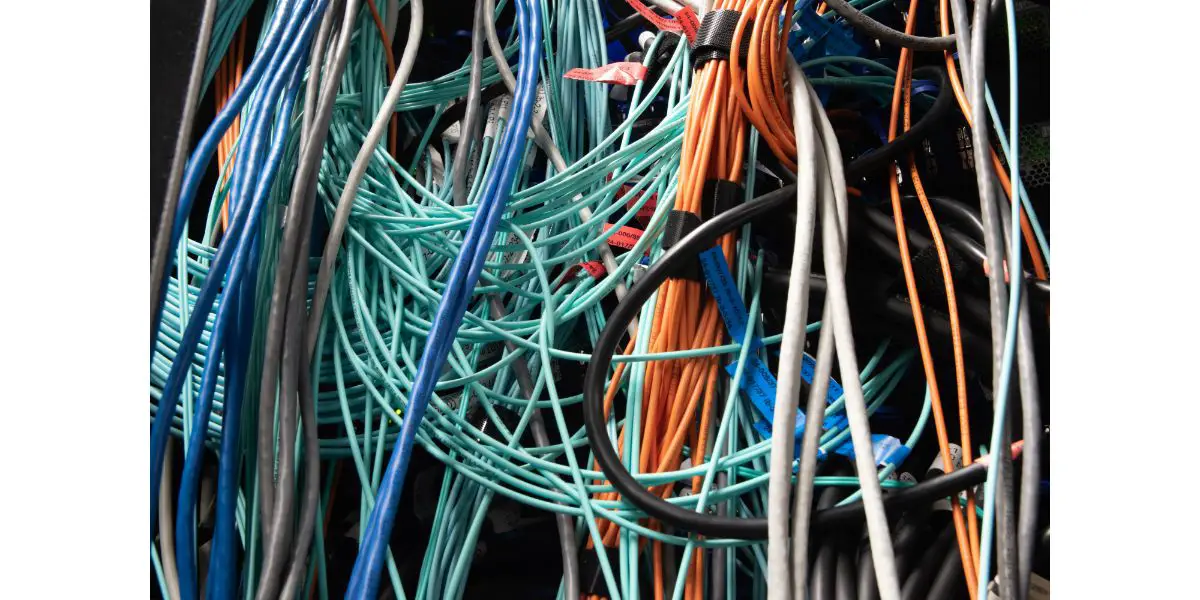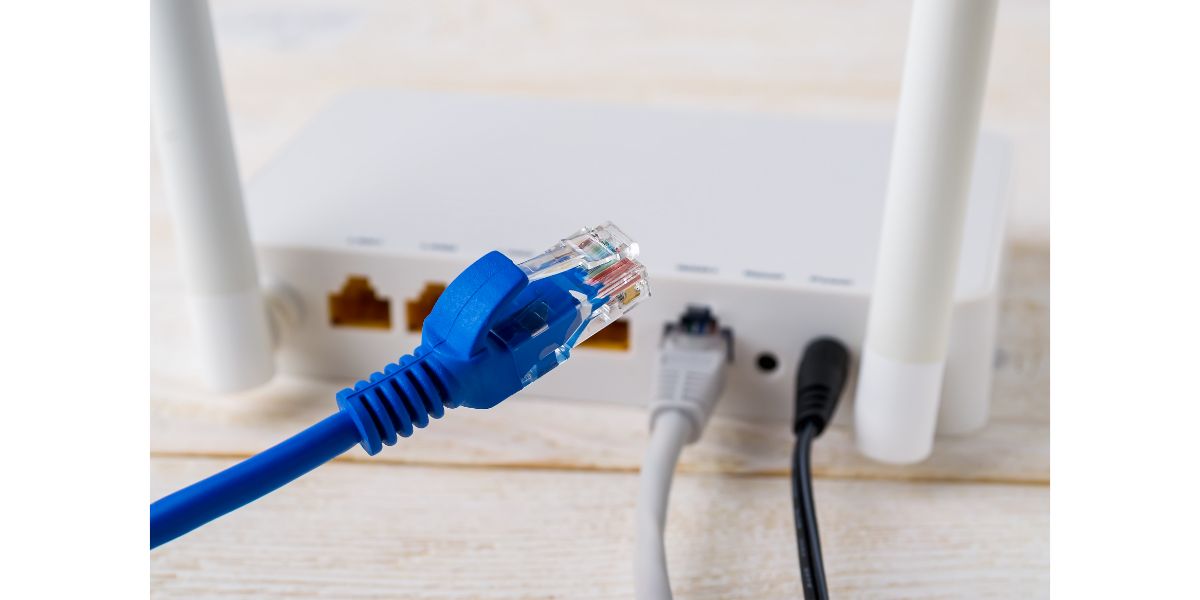Disclaimer: This post may contain affiliate links, meaning we get a small commission if you make a purchase through our links, at no cost to you. For more information, please visit our Disclaimer Page.
Ethernet cables go bad because they’re bent, stored incorrectly, damaged, or the connectors are chipped. Additional causes include connectivity problems, overheated wires, and loose terminals. Ethernet cables usually go bad in 5 to 7 years.
Table of Contents
1. Bent Cables and Cords
One of the most common reasons Ethernet cables stop working is because the cables are bent or creased. These cables need to be as straight as possible, aside from a couple of turns if absolutely necessary.
Many people make the mistake of putting Ethernet cables behind routers and modems that are pressed against the wall. Doing so creates a 90-degree crease at the front of the cable, putting a lot of stress on the connectors.
How To Fix
If your Ethernet cable is bent or creased, here are your options:
- Wrap electrical tape around the cable while it’s straight and flat on the ground. This will help the cable hold its shape much better. Plug it into the router or modem without bending it as much as possible.
- Turn your router, modem, or computer in a direction that doesn’t create an immediate right angle in the cable. The positioning of your computer or modem is the most common reason creases form.
- If the cable is bent and starting to open or tear, replace it. Try the Cat8 Ethernet Cable (available on Amazon.com) for a quick, reliable connection speed. The gold-plated connectors are durable and UV-resistant, and the flat cable prevents it from tangling.
2. Damaged or Exposed Wires
After bending or creasing the wires for too long, they can become irreparably damaged. Weak plastic exposes the wires, making them susceptible to breakages or leaks. If water gets in the Ethernet cable, it’ll never work again.
Also, by pulling Ethernet cables forcefully, many people unintentionally loosen or break the wires inside of the outer plastic. Not only will this cause electrical damage, but it can also mean that you have to replace the connection terminals on your router, modem, or computer.
How To Fix
The only thing you can do for a damaged, broken, or exposed Ethernet cable is to replace it. Some videos and guides suggest wrapping the exposed portion in electrical tape, but it’s not worth risking permanent damage to your router, computer, or modem.
The only time you should use electrical tape on an Ethernet cable is when it’s bent. Once the wires are exposed, they’ll begin to fray under the tape. You won’t notice anything is wrong until the wire stops working and the device shows connection errors.
3. Chipped Ethernet Cable Connector
Every Ethernet cable has a connector at the end known as an RJ45. These connectors house the wires and connect them to the terminals on your computer, modem, or another device. If the connector is chipped, it won’t work for two reasons:
- The exposed wires are susceptible to water damage and loose connections.
- The chipped connector might not fit in the terminal, which prevents it from establishing a reliable connection.
How To Fix
Old-school Ethernet cables were stuck in one piece. These days, you can separate the connectors from the cables, letting you replace either part within minutes.
Here’s how you can replace the connector:
- Disconnect both ends of the Ethernet cable from any powered device.
- Cut about one inch behind the damaged connector.
- Strip the end of the wire to expose about half an inch (or however deep the new connector is).
- Separate the exposed wires, then place them into the connection terminals inside the new RJ45 connector.
- Crimp the end of the connector to secure the wires.
Make sure you leave enough room for the wire to connect to both ends without stretching it. Never cut more than a couple of inches off of both sides.
4. Improper Storage Issues
One of the biggest mistakes you can make with an Ethernet cable is wrapping or tangling it before storing it for long periods. Improper storage can put a lot of stress on the protective plastic coating and the internal wires of the cable. It can also form long-term creases, like bending the wires to plug them behind furniture.
Another problem is when people store too many cables together. Your Ethernet cables are bound to tangle with other cords, making them bend and crease.
How To Fix
Follow these tips for the best way to store your Ethernet cables without damaging them:
- Disconnect the wire from both ends.
- Wrap the wire around an empty wire spool to prevent creases.
- Place the Ethernet wire spool in an airtight storage container away from sharp objects.
The Bluemoona Empty Wire Spool (available on Amazon.com) comes in a 10-piece set that measures 3.3 inches (8.38 cm) wide each. It’s perfect for Ethernet cable storage because it doesn’t cause exposed wires, crease marks, or broken connectors and terminals.
If you don’t have a wire spool or you don’t want to get one, you can wrap the wire in a circle around your shoulder (much like the classic garden hose storage trick). Once you have your Ethernet cable in a circle, wrap two or three zip ties or Velcro strips around it to prevent it from loosening.
5. Connectivity Failure
In addition, RJ45 Ethernet cables might have connectivity issues, preventing them from working with any terminal. This is quite common in older Ethernet cables, but it can also happen to a damaged Ethernet wire.
It’s very rare that your RJ45 cables won’t be compatible with your modem or router. However, it can happen if you choose a cable that’s not the right size, make, or model as recommended by the manufacturer.
How To Fix
There are two ways to check if your Ethernet cable has connection issues:
- Plug it into multiple devices to find out if each of them blinks or displays error codes. This is a clear indication that you need to replace or repair the Ethernet cable. If it works with some devices, it could be that it fits the company’s length and speed recommendations.
- Use an RJ45 cable tester. We suggest the iMBA Price Network Cable Tester (available on Amazon.com). Plug the Ethernet cable into the tester port to find out what’s wrong with it. It’ll display one of eight lights to let you know if everything is working properly.
6. Old, Worn Ethernet Cable
Ethernet cables go bad after long-term use, regardless of how well they were maintained. Also, most Ethernet cables can last up to 7 years. You’ll have to replace them after this time span because they’re more prone to the following problems:
- Wiggling cables
- Loose RJ45 connectors
- Creases or bent cords
- Connectivity errors
- Overheating
There’s no need to replace your old Ethernet cables if they still work. However, it’s a good idea to keep a couple of spare cords available if your current setup stops working. Furthermore, you’ll likely be far from the manufacturer’s warranty period.
How To Fix
If your faulty Ethernet cable is older than five years and is out of the manufacturer’s warranty, we recommend replacing it. Getting a new Ethernet cable can make a world of difference. Don’t forget to run your cable through the aforementioned testing process to ensure it’s the cable’s fault, not the router or modem.
7. Oversized Cable Length
Your Ethernet cable’s length can determine how long it lasts. For instance, if you use a cable that’s too long, it won’t be nearly as efficient. Check your router or modem’s recommended cable length to determine which size you should use.
The same can be said for low-quality, generic RJ45 cables. Avoid bad Ethernet cables if they come from a non-reputable manufacturer. These cables are often oversized to seem convenient, but they end up doing more harm than good.
How To Fix
Try these suggestions:
- Check the required cable length on the back of your router, modem, or computer. You may look in the user’s manual if you can’t find the recommendations on the device.
- Shorten your Ethernet cable by cutting it and replacing the connector pieces, then crimping them to the wires. Only do this if your cable fits the recommended speeds.
- Get a new Ethernet cable that fits the measurements on the device. This is the best option, though not always the most practical one.
Unfortunately, there’s not much else you can do to fix oversized or undersized Ethernet cables. Always opt for a high-speed, high-quality Ethernet cable if you want to avoid slow speeds, connectivity issues, or incompatibility. If you’re interested in what else can happen with an oversized ethernet cable, we have an article here answering that question.
8. Mishandling the Modem or Router
Mishandling the modem or router can break or damage an Ethernet cable. The cables are relatively durable, but the connectors can crack if they’re dropped. It’s important to avoid moving or tossing the unit if it’s attached to an Ethernet cable or a power cable.
Similarly, you should always disconnect the cable from the device before storing anything. Never store everything wrapped or bundled together. It can strain the connectors, terminals, and wires. You’ll end up with wiggling issues and connection errors blinking all over the device.
How To Fix
The good news is that it’s very easy to avoid damaging your Ethernet cable when handling your router and modem. Always keep these three must-know tips in mind:
- Disconnect the Ethernet cable before moving the connected device, regardless of how far you’re moving it.
- Pinch the connection port to loosen it from the terminal before removing the cable from the device.
- Never pull or disconnect an Ethernet cable by the cord. Instead, grab the plastic or plated connector.
9. Overheated Ethernet Cable
Ethernet cables don’t handle heat very well. In fact, they can expand and contract if they get mildly warm. While these slight adjustments are hardly noticeable and rarely problematic, high-heat fluctuations can cause irreparable damage.
These cables overheat for many different reasons, including:
- Being covered by blankets and other fabrics
- Using too much electrical tape
- Old, worn cables
- Old, malfunctioning modems, routers, and other devices
- Close proximity to heating devices, such as fireplaces, space heaters, and electric blankets.
How To Fix
You can avoid overheating your Ethernet cable by following these tips:
- Never wrap your Ethernet cables in anything other than cable organizers.
- Ensure the cable isn’t covered by blankets or furniture. This is only acceptable if the furniture hovers over the cable, not pressing against it.
- Keep all Ethernet cables at least several feet away from any heat source.
- Toss damaged or torn Ethernet cables that can overheat from electrical issues.
Ethernet cables rarely cause short circuits since they don’t directly carry power from an outlet. However, an overheated Ethernet cable can increase the connected device’s temperature, which can cause the breaker to trip or the thermal fuse to blow.
10. Loose Connection Terminals
Loose terminals are quite common in older routers and modems. They can prevent an Ethernet cable from establishing a solid connection, which overheats the cable. You might need to replace the port or the device rather than the cable.
The easiest way to know if you have a damaged terminal is by trying multiple cables in the same terminal. You can also connect your Ethernet cable to another device to see if it wiggles a bit. If it doesn’t, then the fault lies in the router or modem.
How To Fix
If the terminals on the router and modem work fine with other Ethernet cables, you can apply one or more of these suggestions:
- Look for chips on the connection port and replace the connector if necessary.
- Opt for a gold-plated Ethernet cable connector rather than a plastic connector because they’re less likely to break.
- Make sure each of the wires in the connector is touching the corresponding terminals.
- Check if the connector is crimped on the Ethernet cable.
- Replace the bad Ethernet cable since it’s likely beyond its average lifespan.
You’ll notice the vast majority of Ethernet cables don’t have many problems until they’re older than five years. If you’ve tried all of the solutions above to no avail, it’s time to get a new cable.
Final Thoughts
Damaged Ethernet cables can rarely be repaired. Your best bet is to get a new cable with the proper length and follow proper storage or usage methods. Make sure the cable isn’t bent, overheated, covered, or stretched too far.



